[Схемотехника, DIY или Сделай сам, Электроника для начинающих] Compensation for Error Caused by Limited Gain-Bandwidth of Operational Amplifiers in Low-pass Filters
Автор
Сообщение
news_bot ®
Стаж: 7 лет 10 месяцев
Сообщений: 27286

An operational amplifier has the internal compensation circuit for stability which limits its working bandwidth. Frequency response of the compensated Op Amp has slope of −6 dB/octave or −20 dB/decade. Unity gain frequency defines the bandwidth where the Op Amp is able to amplify a signal. If we multiply the gain and frequency at any point, the result is the same, allowing us to use this parameter to select the appropriate Op Amp. It is called Gain-Bandwidth Product, GBW or GBP. The limited open-loop gain introduces a closed-loop gain and phase error.
But we want to optimize our circuits, right?

Closed-loop gain of the Non-Inverting and Inverting Amplifier
The closed-loop gain of the non-inverting amplifier is:
A
G = ———————
1 + A β
and for the inverting amplifier:
A (1 − β)
G = − —————————
1 + A β
where:
A is the open-loop gain;
β is the feedback fraction.
Let’s calculate, for example, an inverting amplifier with desired gain of 1 when A = 100, β = R1 / (R1+R2) = 0.5:
A (1 − β) 100 × (1 − 0.5) 50
G= − ————————— = − ——————————————— = − —— ≈ −0.98
1 + A β 1 + 100 × 0.5 51
and A=1:
A (1 − β) 1 × (1 − 0.5)
G= − ————————— = − ————————————— ≈ −0.333
1 + A β 1 + 1 × 0.5
But to make a real Op Amp stable, A is frequency dependent and there is a phase shift, how you can see in the picture below.

Frequency response of the compensated Op Amp without a feedback network
Gain-Bandwidth Product (GBW) = A × F is a constant, and the greater the GBW is, the faster and expensive the Op Amp is. Of course, A cannot be infinity, so we see a shelf at low frequencies due to a finite gain.

The inverting amplifier with ideal and compensated Op Amp.
The figure shows the difference between the ideal and compensated Op Amp with GBW = 1 MHz. You can see that the cyan line of the compensated Op Amp is always below the yellow line showing its open-loop gain and there must be some margin.
However, the simulator shows that gain at 1 МГц is not -9.55 dB, but about -7 dB due to a phase shift at the output.
The closed-loop gain error versus gain margin for the non-inverting amplifier looks likes that:

Closed-loop gain error vs Gain margin of the non-inverting amplifier.
Error compensation for 2-nd order low-pass filter
This equation is usually used to compute the GBW of an Op Amp:
GBW(Hz) = 100 × Q × G × F3
where:
Q is the quality factor of the filter;
G is the specified gain;
F3 is the cutoff frequency at -3 dB;
100 is the gain margin.
Why? A low-pass filter with Q > 0.707 has a peak and we need to multiply the gain with this peak value to account it. The peak value is:
Q
β = ————————————————————— ≈ Q
sqrt(1 − 1 / (4 Q^2))
The most of used filters are low-pass filters for ADCs and DACs. So even for an LPF with 150 kHz an Op Amp with GBW of 15 MHz is desirable.
Texas Instruments’ engineers shared a method to reduce the requirement in [1][2].
Let’s try to figure out how to use their equations in practice.
Multiple FeedBack LPF
Let’s compute a 2-nd order LPF with bandwidth of 150 kHz, gain of 1 and quality factor of 0.707.

2-nd order MFB LPF
The required GBW is:
GBW(Hz) = 100 × Q × G × F3 = 100 × 0.707 × 1 × 150 kHz ≈ 10.5 MHz
Let’s try to use an Op Amp with GBW of 1 MHz.
Add R4 in series with C2:
1 1
R4 = ———————————————— = ——————————————————— = 2122 ≈ 2.1k (E96)
2 × π × GBW × C2 2 × π × 1MHz × 75pF
Change R3:
R3' = R3 − R4 = 4990 − 2100 = 2868 ≈ 2.87k (E96)
And finally enter the values into a simulator:

Error compensation for 2-nd order MFB LPF
The top circuit and green color on the charts: the ideal amplifier.
The middle circuit and cyan color on the charts: the Op Amp with GBW of 1 MHz.
The bottom circuit and yellow color on the charts: the Op Amp with GBW of 1 MHz and with the error compensation.
When R3 is too low, the R3’ value may be negative. In such cases you should recalculate the filter with a greater R3 value.
Sallen-Key LPF
Let’s compute a 2-nd order LPF with bandwidth of 150 kHz, gain of 1 and quality factor of 0.707.
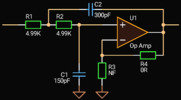
2-nd order Sallen-Key LPF
The required GBW is:
GBW(Hz) = 100 × Q × G × F3 = 100 × 0.707 × 1 × 150kHz ≈ 10.5 MHz
Let’s try to use an Op Amp with GBW of 1 MHz.
Add R5 in series with C1:
R3 + R4 ∞ + 0 1
R5 = ————————————————————— = ———————————————————————— = ———————————————————— = 1061 ≈ 1.07k (E96)
2 × π × GBW × C1 × R3 2 × π × 1MHz × 150pF × ∞ 2 × π × 1MHz × 150pF
Change R2:
R2' = R2 − R5 = 4990 − 1070 = 3920 = 3.92k (E96)
And finally enter the values into a simulator:
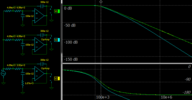
Error compensation for 2-nd order Sallen-Key LPF
The top circuit and green color on the charts: the ideal amplifier.
The middle circuit and cyan color on the charts: the Op Amp with GBW of 1 MHz.
The bottom circuit and yellow color on the charts: the Op Amp with GBW of 1 MHz and with the error compensation.
Error compensation for Type II compensation network with Op Amp
Let’s try to apply the same method to the Type II compensation network with Op Amp used in switching-mode power supplies.
Consider a Type II circuit with parameters: the zero at 2 kHz, the pole at 300 kHz, the middle gain is 0 dB.
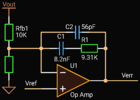
Type 2 compensation with Op Amp
Conservative calculation of the required GBW:
GBW(Hz) = M × Fpole × Gfp = 100 ×300kHz × 0.707 ≈ 21 MHz
where:
M=100 is the gain margin of the Op Amp at a frequency in times;
Fpole is the pole frequency in Hz;
Gfp is the gain at the pole frequency in times.
Christophe Basso in [4] gives another calculation:
GBW(Hz) = M × (20 Fcross) × Gfc = 20 × 20 × 5kHz × 1 ≈ 2 MHz
where:
M=20 is the gain margin of the Op Amp at a frequency in times;
20 Fcross is the frequency with maximum phase boost in Hz with the factor to account the pole position;
Gfc is the gain at the Fcross frequency in times.
The transfer function of the circuit is:
C1 R1 s + 1
H(s) = − ——————————————————————————————————————————————
(s Rfb1 (C1 + C2))(s C1 C2 R1 / (C1 + C2) + 1)
Add R2 in series with C2. The new transfer function is:
1 + (C1 R1 + C2 R2) s + (C2 C1 R1 R2) s^2
H(s) = − ——————————————————————————————————————————————————————
(s Rfb1 (C1 + C2)) (s C2 C1 (R2 + R1) / (C1 + C2) + 1)
Change the C2 value and find the R2 value:
1
C2' = C2 − ————————————————
2 × π × GBW × R1
1
R2 = —————————————————
2 × π × GBW × C2'
Now try to use an Op Amp with GBW = 1 MHz in this circuit.
Recalculate the circuit values using the equations above and see the result.
Adjust the C2 value:
1
C2' = 56pF − —————————————————— = 40pF ≈ 39pF (E24)
2 × π × 1MHz × 10k
The R2 value:
1
R2 = ——————————————————— = 4k ≈ 3.9k (E24)
2 × π × 1MHz × 39pF
And finally enter the values into a simulator:
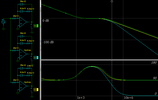
Error compensation for Type 2 compensation network with Op Amp
The top circuit and green color on the charts: the ideal amplifier.
The middle circuit and cyan color on the charts: the Op Amp with GBW of 1 MHz.
The bottom circuit and yellow color on the charts: the Op Amp with GBW of 1 MHz and with the error compensation.
Error compensation for Type II compensation network with Optocoupler without Fast Lane
There are 2 variants of the circuit: with an Op Amp and a shunt regulator like TL431.
We will use the same parameters: the zero at 2 kHz, the pole at 300 kHz, the middle gain is 0 dB, the current transfer ratio of an optocoupler is 1.

Type 2 compensation with Optocoupler without Fast Lane
The transfer function of both circuits is (C1=Cz, R1=Rz):
CTR Rp (1 + C1 R1) s
H(s) = − —————— —————————————————————————
Rd (C1 Rfb1 s) (1 + Cp Rp s)
where CTR is the current transfer ratio of the optocoupler.
Add Rc in series with Cp. The new transfer function is:
CTR Rp (1 + (C1 R1 + Cp Rc) s + (Cp C1 R1 Rc) s^2)
H(s) = − —————— ———————————————————————————————————————————
Rd (C1 Rfb1 s) (1 + Cp (Rp + Rc) s)
Change the C2 value and find the Rc value:
1
Cp' = Cp − ————————————————
2 × π × GBW × Rp
1
Rc = —————————————————
2 × π × GBW × Cp'
Try to use an Op Amp with GBW = 1 MHz in this circuit.
Recalculate the circuit values using the equations above and see the result.
Adjust the Cp value:
1
Cp' = 51pF − —————————————————— = 35.1pF ≈ 36pF (E24)
2 × π × 1MHz × 10k
The Rc value:
1
Rc = ——————————————————— = 4.421k ≈ 4.42k (E96)
2 × π × 1MHz × 36pF
The extra DC gain is:
CTR Rp 1 × 10k
A = —————— = ——————— = 1
Rd 10k
And finally enter the values into a simulator:
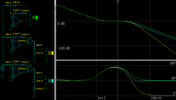
Error compensation for Type 2 compensation network with Optocoupler without Fast Lane
The top circuit and green color on the charts: the ideal amplifier.
The middle circuit and yellow color on the charts: the Op Amp with GBW of 1 MHz.
The bottom circuit and cyan color on the charts: the Op Amp with GBW of 1 MHz and with the error compensation.
Do not forget, that a real optocoupler has a parasitic capacitance and its value should be taken into account.
Conclusion
The described methods help to reduce the requirement to the Gain-Bandwidth of a used Op Amp and cost of circuits.
For filters, they work well with commonly used quality factors below 1.
References
- TI, Vito Shen, Thomas Kuehl, «Compensation Methodology for Error in Multiple-Feedback Low-Pass Filter, Caused by Limited Gain-Bandwidth of Operational Amplifiers».
- TI, Vito Shen, Thomas Kuehl, «Compensation Methodology for Error in Sallen-Key Low-Pass Filter, Caused by Limited Gain-Bandwidth of Operational Amplifiers».
- Christophe Basso, «UnderstandingOp Amp Dynamic Response In AType-2 Compensator (Part 1): The Open-Loop Gain».
- Christophe Basso, «Understanding Op Amp Dynamic Response In A Type-2 Compensator (Part 2): The Two Poles».
- Christophe Basso, “The TL431 in Switch-Mode Power Supplies loops”.
- «idealCircuit», simulator.
- «Circuit Calculator», electronics circuit design tool.
===========
Источник:
habr.com
===========
Похожие новости:
- [DIY или Сделай сам, Виртуализация, Конференции] Now you see us — 2. Лайфхаки для подготовки к онлайн-конференции
- [Периферия, Электроника для начинающих] Варианты аппаратной реализации USB Type-C, или Когда не требуется Power Delivery
- [Компьютерное железо, DIY или Сделай сам] Сборка очень компактного планшетного ПК на базе Core i7
- [DIY или Сделай сам, Умный дом] Умелец создал систему, которая побуждает птиц собирать крышки от бутылок в обмен на корм
- [DIY или Сделай сам, Электроника для начинающих] Разбираем мини-глушилку GPS (перевод)
- [Научно-популярное, DIY или Сделай сам, Транспорт, Будущее здесь] Летающая турбореактивная платформа для парамедиков
- [FPGA, Анализ и проектирование систем, История IT, Старое железо, Электроника для начинающих] Обратная разработка XC2064 — первой микросхемы FPGA (перевод)
- [DIY или Сделай сам, Здоровье] Мой капитальный ремонт в сталинке
- [3D-принтеры, DIY или Сделай сам, Программирование микроконтроллеров] Как управлять CNC-роутером, не привлекая внимания…
- [DIY или Сделай сам, Космонавтика, Научно-популярное, Программирование микроконтроллеров] Per aspera ad astra, или как я строил ракету. Часть 2. Собираем альтиметр на STM32 и BMP280
Теги для поиска: #_shemotehnika (Схемотехника), #_diy_ili_sdelaj_sam (DIY или Сделай сам), #_elektronika_dlja_nachinajuschih (Электроника для начинающих), #_electronics, #_circuit_design, #_shemotehnika (
Схемотехника
), #_diy_ili_sdelaj_sam (
DIY или Сделай сам
), #_elektronika_dlja_nachinajuschih (
Электроника для начинающих
)
Вы не можете начинать темы
Вы не можете отвечать на сообщения
Вы не можете редактировать свои сообщения
Вы не можете удалять свои сообщения
Вы не можете голосовать в опросах
Вы не можете прикреплять файлы к сообщениям
Вы не можете скачивать файлы
Текущее время: 12-Дек 19:07
Часовой пояс: UTC + 5
| Автор | Сообщение |
|---|---|
|
news_bot ®
Стаж: 7 лет 10 месяцев |
|
 An operational amplifier has the internal compensation circuit for stability which limits its working bandwidth. Frequency response of the compensated Op Amp has slope of −6 dB/octave or −20 dB/decade. Unity gain frequency defines the bandwidth where the Op Amp is able to amplify a signal. If we multiply the gain and frequency at any point, the result is the same, allowing us to use this parameter to select the appropriate Op Amp. It is called Gain-Bandwidth Product, GBW or GBP. The limited open-loop gain introduces a closed-loop gain and phase error. But we want to optimize our circuits, right?  Closed-loop gain of the Non-Inverting and Inverting Amplifier The closed-loop gain of the non-inverting amplifier is: A G = ——————— 1 + A β and for the inverting amplifier: A (1 − β) G = − ————————— 1 + A β where: A is the open-loop gain; β is the feedback fraction. Let’s calculate, for example, an inverting amplifier with desired gain of 1 when A = 100, β = R1 / (R1+R2) = 0.5: A (1 − β) 100 × (1 − 0.5) 50 G= − ————————— = − ——————————————— = − —— ≈ −0.98 1 + A β 1 + 100 × 0.5 51 and A=1: A (1 − β) 1 × (1 − 0.5) G= − ————————— = − ————————————— ≈ −0.333 1 + A β 1 + 1 × 0.5 But to make a real Op Amp stable, A is frequency dependent and there is a phase shift, how you can see in the picture below.  Frequency response of the compensated Op Amp without a feedback network Gain-Bandwidth Product (GBW) = A × F is a constant, and the greater the GBW is, the faster and expensive the Op Amp is. Of course, A cannot be infinity, so we see a shelf at low frequencies due to a finite gain.  The inverting amplifier with ideal and compensated Op Amp. The figure shows the difference between the ideal and compensated Op Amp with GBW = 1 MHz. You can see that the cyan line of the compensated Op Amp is always below the yellow line showing its open-loop gain and there must be some margin. However, the simulator shows that gain at 1 МГц is not -9.55 dB, but about -7 dB due to a phase shift at the output. The closed-loop gain error versus gain margin for the non-inverting amplifier looks likes that:  Closed-loop gain error vs Gain margin of the non-inverting amplifier. Error compensation for 2-nd order low-pass filter This equation is usually used to compute the GBW of an Op Amp: GBW(Hz) = 100 × Q × G × F3 where: Q is the quality factor of the filter; G is the specified gain; F3 is the cutoff frequency at -3 dB; 100 is the gain margin. Why? A low-pass filter with Q > 0.707 has a peak and we need to multiply the gain with this peak value to account it. The peak value is: Q β = ————————————————————— ≈ Q sqrt(1 − 1 / (4 Q^2)) The most of used filters are low-pass filters for ADCs and DACs. So even for an LPF with 150 kHz an Op Amp with GBW of 15 MHz is desirable. Texas Instruments’ engineers shared a method to reduce the requirement in [1][2]. Let’s try to figure out how to use their equations in practice. Multiple FeedBack LPF Let’s compute a 2-nd order LPF with bandwidth of 150 kHz, gain of 1 and quality factor of 0.707.  2-nd order MFB LPF The required GBW is: GBW(Hz) = 100 × Q × G × F3 = 100 × 0.707 × 1 × 150 kHz ≈ 10.5 MHz Let’s try to use an Op Amp with GBW of 1 MHz. Add R4 in series with C2: 1 1 R4 = ———————————————— = ——————————————————— = 2122 ≈ 2.1k (E96) 2 × π × GBW × C2 2 × π × 1MHz × 75pF Change R3: R3' = R3 − R4 = 4990 − 2100 = 2868 ≈ 2.87k (E96) And finally enter the values into a simulator:  Error compensation for 2-nd order MFB LPF The top circuit and green color on the charts: the ideal amplifier. The middle circuit and cyan color on the charts: the Op Amp with GBW of 1 MHz. The bottom circuit and yellow color on the charts: the Op Amp with GBW of 1 MHz and with the error compensation. When R3 is too low, the R3’ value may be negative. In such cases you should recalculate the filter with a greater R3 value. Sallen-Key LPF Let’s compute a 2-nd order LPF with bandwidth of 150 kHz, gain of 1 and quality factor of 0.707.  2-nd order Sallen-Key LPF The required GBW is: GBW(Hz) = 100 × Q × G × F3 = 100 × 0.707 × 1 × 150kHz ≈ 10.5 MHz Let’s try to use an Op Amp with GBW of 1 MHz. Add R5 in series with C1: R3 + R4 ∞ + 0 1 R5 = ————————————————————— = ———————————————————————— = ———————————————————— = 1061 ≈ 1.07k (E96) 2 × π × GBW × C1 × R3 2 × π × 1MHz × 150pF × ∞ 2 × π × 1MHz × 150pF Change R2: R2' = R2 − R5 = 4990 − 1070 = 3920 = 3.92k (E96) And finally enter the values into a simulator:  Error compensation for 2-nd order Sallen-Key LPF The top circuit and green color on the charts: the ideal amplifier. The middle circuit and cyan color on the charts: the Op Amp with GBW of 1 MHz. The bottom circuit and yellow color on the charts: the Op Amp with GBW of 1 MHz and with the error compensation. Error compensation for Type II compensation network with Op Amp Let’s try to apply the same method to the Type II compensation network with Op Amp used in switching-mode power supplies. Consider a Type II circuit with parameters: the zero at 2 kHz, the pole at 300 kHz, the middle gain is 0 dB.  Type 2 compensation with Op Amp Conservative calculation of the required GBW: GBW(Hz) = M × Fpole × Gfp = 100 ×300kHz × 0.707 ≈ 21 MHz where: M=100 is the gain margin of the Op Amp at a frequency in times; Fpole is the pole frequency in Hz; Gfp is the gain at the pole frequency in times. Christophe Basso in [4] gives another calculation: GBW(Hz) = M × (20 Fcross) × Gfc = 20 × 20 × 5kHz × 1 ≈ 2 MHz where: M=20 is the gain margin of the Op Amp at a frequency in times; 20 Fcross is the frequency with maximum phase boost in Hz with the factor to account the pole position; Gfc is the gain at the Fcross frequency in times. The transfer function of the circuit is: C1 R1 s + 1 H(s) = − —————————————————————————————————————————————— (s Rfb1 (C1 + C2))(s C1 C2 R1 / (C1 + C2) + 1) Add R2 in series with C2. The new transfer function is: 1 + (C1 R1 + C2 R2) s + (C2 C1 R1 R2) s^2 H(s) = − —————————————————————————————————————————————————————— (s Rfb1 (C1 + C2)) (s C2 C1 (R2 + R1) / (C1 + C2) + 1) Change the C2 value and find the R2 value: 1 C2' = C2 − ———————————————— 2 × π × GBW × R1 1 R2 = ————————————————— 2 × π × GBW × C2' Now try to use an Op Amp with GBW = 1 MHz in this circuit. Recalculate the circuit values using the equations above and see the result. Adjust the C2 value: 1 C2' = 56pF − —————————————————— = 40pF ≈ 39pF (E24) 2 × π × 1MHz × 10k The R2 value: 1 R2 = ——————————————————— = 4k ≈ 3.9k (E24) 2 × π × 1MHz × 39pF And finally enter the values into a simulator:  Error compensation for Type 2 compensation network with Op Amp The top circuit and green color on the charts: the ideal amplifier. The middle circuit and cyan color on the charts: the Op Amp with GBW of 1 MHz. The bottom circuit and yellow color on the charts: the Op Amp with GBW of 1 MHz and with the error compensation. Error compensation for Type II compensation network with Optocoupler without Fast Lane There are 2 variants of the circuit: with an Op Amp and a shunt regulator like TL431. We will use the same parameters: the zero at 2 kHz, the pole at 300 kHz, the middle gain is 0 dB, the current transfer ratio of an optocoupler is 1.  Type 2 compensation with Optocoupler without Fast Lane The transfer function of both circuits is (C1=Cz, R1=Rz): CTR Rp (1 + C1 R1) s H(s) = − —————— ————————————————————————— Rd (C1 Rfb1 s) (1 + Cp Rp s) where CTR is the current transfer ratio of the optocoupler. Add Rc in series with Cp. The new transfer function is: CTR Rp (1 + (C1 R1 + Cp Rc) s + (Cp C1 R1 Rc) s^2) H(s) = − —————— ——————————————————————————————————————————— Rd (C1 Rfb1 s) (1 + Cp (Rp + Rc) s) Change the C2 value and find the Rc value: 1 Cp' = Cp − ———————————————— 2 × π × GBW × Rp 1 Rc = ————————————————— 2 × π × GBW × Cp' Try to use an Op Amp with GBW = 1 MHz in this circuit. Recalculate the circuit values using the equations above and see the result. Adjust the Cp value: 1 Cp' = 51pF − —————————————————— = 35.1pF ≈ 36pF (E24) 2 × π × 1MHz × 10k The Rc value: 1 Rc = ——————————————————— = 4.421k ≈ 4.42k (E96) 2 × π × 1MHz × 36pF The extra DC gain is: CTR Rp 1 × 10k A = —————— = ——————— = 1 Rd 10k And finally enter the values into a simulator:  Error compensation for Type 2 compensation network with Optocoupler without Fast Lane The top circuit and green color on the charts: the ideal amplifier. The middle circuit and yellow color on the charts: the Op Amp with GBW of 1 MHz. The bottom circuit and cyan color on the charts: the Op Amp with GBW of 1 MHz and with the error compensation. Do not forget, that a real optocoupler has a parasitic capacitance and its value should be taken into account. Conclusion The described methods help to reduce the requirement to the Gain-Bandwidth of a used Op Amp and cost of circuits. For filters, they work well with commonly used quality factors below 1. References
=========== Источник: habr.com =========== Похожие новости:
Схемотехника ), #_diy_ili_sdelaj_sam ( DIY или Сделай сам ), #_elektronika_dlja_nachinajuschih ( Электроника для начинающих ) |
|
Вы не можете начинать темы
Вы не можете отвечать на сообщения
Вы не можете редактировать свои сообщения
Вы не можете удалять свои сообщения
Вы не можете голосовать в опросах
Вы не можете прикреплять файлы к сообщениям
Вы не можете скачивать файлы
Вы не можете отвечать на сообщения
Вы не можете редактировать свои сообщения
Вы не можете удалять свои сообщения
Вы не можете голосовать в опросах
Вы не можете прикреплять файлы к сообщениям
Вы не можете скачивать файлы
Текущее время: 12-Дек 19:07
Часовой пояс: UTC + 5
